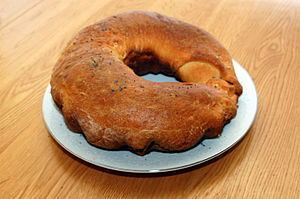Type Pastry | Place of origin Poland | |
 | ||
Main ingredients Dough, Cheese, Butter, Flour Similar Dough, Cheese, Flour, Butter, Marry girl cake | ||
Ko acz w gierski pobte patelnie
Kołacz ([ˈkɔwat͡ʂ]) meaning cake, wheel cake, or coffee cake (variously transliterated as kolach, kolachky, kolacky, kolachy, from Polish: Koło: "disk") is a traditional Polish pastry, originally a wedding cake dating to the start of the 13th century, that has made its way into American homes around the Christmas and Easter holidays. The pastry is a light and flaky dough filled with a variety of sweet and savory fillings such as apricot, raspberry, prune, sweet cheese, poppy seed or even a nut mixture. Variants of the traditional Slavic pastry have found entrance into many Central and Eastern European cuisines, e.g. the Czech leven yeast dough called kolache (koláč). When the dough and filling mixture is rolled it is also known as a makowiec, makownik, poteca, strucla z makiem (poppy seed strusel), strucla orzechowa (walnut strusel), strucla z migdalowa (almonds strusel). In Hungarian this is called, Diós-mákos Beigli or Bejgli. Some sprinkle the roll with poppy seeds or powdered sugar on top and can be baked in a circular pan or long-ways in a jelly pan like a log.
Contents
The Polish pastry is made from a special dough that combines cream cheese with butter and flour. This ingredient mixture gives it a unique flakey quality similar to a pie crust. For individual servings, the dough is rolled thin and then cut into squares. A thin line of the filling is spread along the diagonal of the square. Then two opposing corners are folded over each other to create the unique shape of the pastry. When made in a large batch or in a roll, servings are sliced off like bread.
